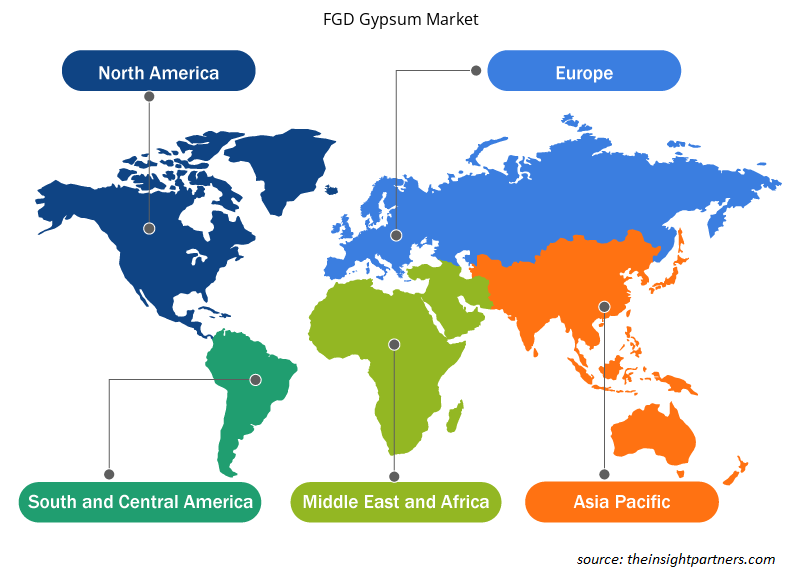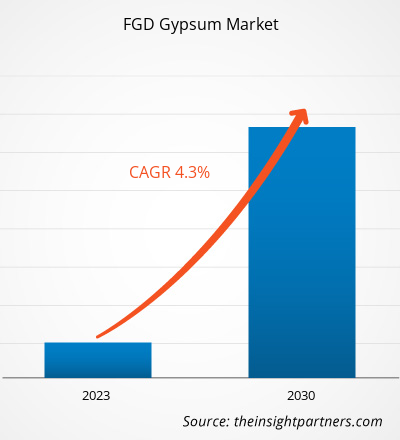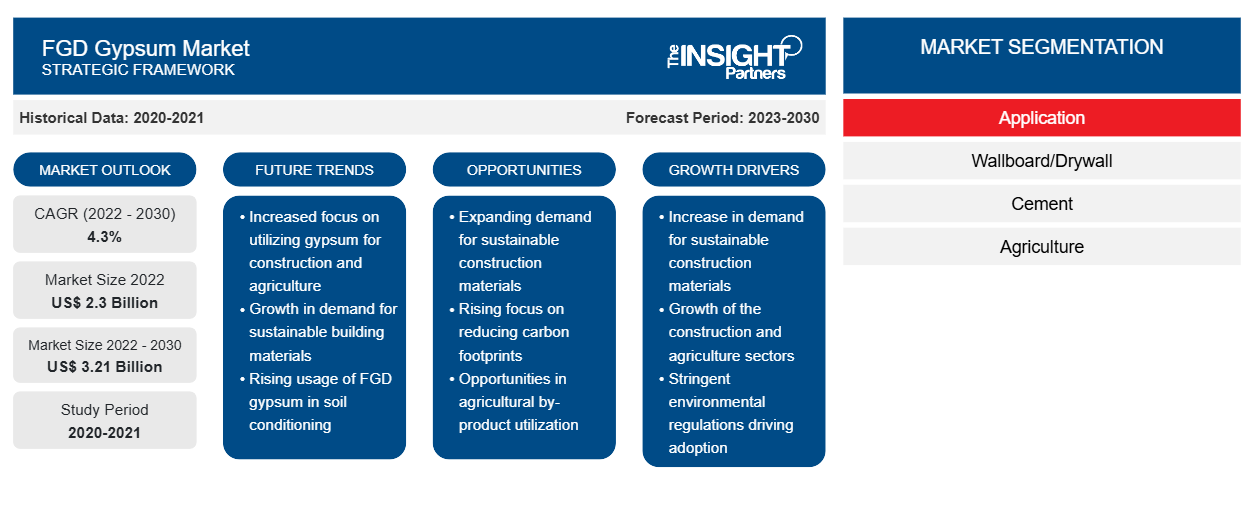[調査レポート] FGD石膏市場規模は、2022年の22億9,856万米ドルから2030年には32億700万米ドルに成長すると予想されており、2022年から2030年にかけて4.3%のCAGRを記録すると予測されています。
市場洞察とアナリストの見解:
FGD 石膏は、石炭火力発電所の燃料ガス脱硫 (FGD) プロセスから生成される副産物です。このプロセスは、環境規制に準拠するために燃料ガスから二酸化硫黄 (SO2) 排出物を除去するために使用されます。FGD 石膏は、さまざまな用途で天然石膏の代替品として使用できる貴重な材料です。特に建設部門は、石膏ボードやセメントの製造に使用されるため、FGD 石膏の主要消費者です。厳しい環境規制と排出基準により、発電所は FGD システムを採用するようになり、FGD 石膏の生産量が増加しました。
成長の原動力と課題:
石膏は建設業界でセメントや石膏の充填剤として使用され、強度を高めながらコンクリートの硬化時間を短縮します。合成石膏である FGD 石膏は、天然石膏に比べてライフサイクルへの影響が少ないため、非常に好まれています。また、装飾パネル、乾式壁パネル、壁板、石膏ボードの製造にも使用されます。建設業界でこれらのパネルの需要が高まっているため、石膏の需要が高まっています。さらに、石膏ボード (乾式壁パネルとも呼ばれます) は、設置や修理が簡単で、安価で、耐久性が高いため、石膏よりも好まれています。取り付けに時間がかからず、広く入手可能です。耐火性と利用の実現可能性は、住宅および非住宅の建設活動で石膏の使用を増やす一般的な要因です。石膏ボードは、簡単かつ迅速に設置できるため、現代の建物や内装で木製パネルやコンクリート壁の代替品として広く使用されています。ただし、シトロ石膏、フッ素石膏、リン酸石膏、チタン石膏などの天然石膏や合成石膏は、FGD 石膏の代替材料です。最大の石膏生産地域では生産量が多いため、天然石膏のコスト効率は、乾式壁用途での FGD 石膏の好まれ方にマイナスの影響を与える可能性があります。この要因により、FGD 石膏の消費量が減ります。
要件に合わせてレポートをカスタマイズする
このレポートの一部、国レベルの分析、Excelデータパックなど、あらゆるレポートを無料でカスタマイズできます。また、スタートアップや大学向けのお得なオファーや割引もご利用いただけます。
- このレポートの主要な市場動向を入手してください。この無料サンプルには、市場動向から見積もりや予測に至るまでのデータ分析が含まれます。
レポートのセグメンテーションと範囲:
「世界のFGD石膏市場」は、用途に基づいてセグメント化されています。用途に基づいて、市場は壁板/乾式壁、セメント、農業、水処理、その他に分類されています。FGD石膏市場は、地域別に、北米(米国、カナダ、メキシコ)、ヨーロッパ(ドイツ、フランス、イタリア、英国、ロシア、その他のヨーロッパ)、アジア太平洋(オーストラリア、中国、日本、インド、韓国、その他のアジア太平洋)、中東およびアフリカ(南アフリカ、サウジアラビア、UAE、その他の中東およびアフリカ)、南米および中米(ブラジル、アルゼンチン、その他の南米および中米)に分類されています。
セグメント分析:
用途に基づいて、FGD石膏ボード市場は、壁板/乾式壁、セメント、農業、水処理、その他に分類されます。 壁板/乾式壁セグメントは、2022年に最大のシェアを占めました。 壁板または乾式壁は、従来のレンガ/石の壁の代替として使用される建築材料です。 FGD石膏ボードは、建設業界で壁板や乾式壁の形で広く使用されています。 石膏ボードベースの乾式壁パネルのコア成分として使用されます。 乾式壁のコアは構造強度を提供し、軽量でもあります。 FGD石膏ボードには微量の硫酸カルシウム半水和物が含まれており、難燃性に貢献しています。 FGD石膏ボードは、一貫した品質と純度で知られており、乾式壁の製造に有利です。 壁板や乾式壁のメーカーは、天然石膏ボードの効果的な代替品として、FGD石膏ボードなどの合成石膏ボードの利用を増やしています。 これらすべての要因が、世界のFGD石膏ボード市場を後押ししています。
地域分析:
地理に基づいて、FGD石膏市場は、北米、ヨーロッパ、アジア太平洋、南米および中米、中東およびアフリカの5つの主要地域に分割されています。アジア太平洋地域は世界のFGD石膏市場を支配し、地域市場は2022年に13億米ドル以上を占めました。アジア太平洋地域は世界市場への主要な貢献者です。南米および中米は、予測期間中に7%を超える最高のCAGRを記録すると予想されています。南米および中米のFGD石膏市場は、ブラジル、アルゼンチン、その他の南米および中米に分割されています。この地域の市場成長を後押しする主な要因の1つは、建設活動の増加です。米国とブラジルのグリーンビルディング協議会によると、ブラジルは120万平方メートル以上の認証建物を擁し、2021年にはエネルギーと環境デザインにおけるリーダーシップ(LEED)登録で世界第7位にランクされました。国際貿易局によると、アルゼンチン政府は2,000万米ドル規模のインフラプロジェクトに重点を置いています。したがって、建設活動の増加は、今後数年間でFGD石膏市場の拡大を後押しすると予想されます。北米も大幅な成長が見込まれ、2030年までに5億米ドルを超えると予想されています。
業界の発展と将来の機会:
FGD 石膏市場で活動している主要企業が行っているさまざまな取り組みを以下に示します。
- 2022年、ジョージア・パシフィックLLCは、テキサス州スウィートウォーターイーストの石膏ボード工場に約3億米ドルを投資しました。同社は、テキサス州の住宅、商業、産業建設部門の高まるニーズを満たすために、能力を強化することを目指しました。
- 2022年、アダプタベート社は、農業廃棄物と二酸化炭素を吸収する石灰ベースの結合剤から作られた乾式壁を発売しました。このアプローチにより、排出物の多い材料である石膏が不要になりました。同社は、業界標準の石膏ボードを生産することを目的とした、英国ブリストルでのパイロットラインの開発のために290万米ドルを調達しました。
FGD 石膏市場の地域別分析
予測期間を通じて FGD 石膏市場に影響を与える地域的な傾向と要因は、Insight Partners のアナリストによって徹底的に説明されています。このセクションでは、北米、ヨーロッパ、アジア太平洋、中東、アフリカ、南米、中米にわたる FGD 石膏市場のセグメントと地理についても説明します。

- FGD石膏市場の地域別データを入手
FGD石膏市場レポートの範囲
| レポート属性 | 詳細 |
|---|---|
| 2022年の市場規模 | 23億米ドル |
| 2030年までの市場規模 | 32億1000万米ドル |
| 世界のCAGR(2022年 - 2030年) | 4.3% |
| 履歴データ | 2020-2021 |
| 予測期間 | 2023-2030 |
| 対象セグメント | アプリケーション別
|
| 対象地域と国 | 北米
|
| 市場リーダーと主要企業プロフィール |
|
FGD 石膏市場のプレーヤー密度: ビジネスダイナミクスへの影響を理解する
FGD 石膏市場は、消費者の嗜好の変化、技術の進歩、製品の利点に対する認識の高まりなどの要因により、エンドユーザーの需要が高まり、急速に成長しています。需要が高まるにつれて、企業は提供を拡大し、消費者のニーズを満たすために革新し、新たなトレンドを活用し、市場の成長をさらに促進しています。
市場プレーヤー密度とは、特定の市場または業界内で活動している企業または会社の分布を指します。これは、特定の市場スペースに、その市場規模または総市場価値に対してどれだけの競合相手 (市場プレーヤー) が存在するかを示します。
FGD石膏市場で事業を展開している主要企業は次のとおりです。
- ジョージア・パシフィックLLC
- Cez Energeticke Produkty SRO
- EPパワーミネラルズ株式会社
- CASEA株式会社
- ホルシム株式会社
免責事項:上記の企業は、特定の順序でランク付けされていません。

- FGD石膏市場のトップキープレーヤーの概要を入手
COVID-19の影響:
COVID-19パンデミックは、さまざまな国のほぼすべての産業に悪影響を及ぼしました。北米、ヨーロッパ、アジア太平洋(APAC)、中南米(SAM)、中東アフリカ(MEA)でのロックダウン、旅行制限、事業停止により、化学および材料産業を含むいくつかの産業の成長が妨げられました。製造ユニットの停止により、世界のサプライチェーン、製造活動、配送スケジュール、必須および非必須の製品の販売が混乱しました。さまざまな企業が、2020年に製品の配送の遅れと製品販売の低迷を報告しました。パンデミックによる経済不況により、消費者は購入の決定に慎重かつ慎重になりました。特に発展途上地域では、収入の低下と収益見通しの不確実性により、消費者による非必須の購入が大幅に減少しました。FGD石膏の多くのメーカーは、パンデミックの初期段階で消費者の需要が減少したため、利益の減少を報告しました。しかし、2021年末までに多くの国でワクチン接種が完全に完了し、政府はロックダウンや渡航禁止などの特定の規制の緩和を発表しました。人々がさまざまな場所へ旅行するようになり、FGD 石膏の需要が増加しました。これらすべての要因が、さまざまな地域における FGD 石膏市場の成長にプラスの影響を与えました。
競争環境と主要企業:
Georgia-Pacific LLC、Cez Energeticke Produkty SRO、EP Power Minerals GmbH、CASEA GmbH、Holcim Ltd、Knauf Gips KG、Travancore Titanium Products Ltd、Compagnie de Saint-Gobain SA、American Gypsum Co LLC、National Gypsum Co は、世界の FGD 石膏市場で活動する著名な企業です。これらの企業は高品質の FGD 石膏を提供し、世界市場の多くの消費者のニーズに応えています。
- 過去2年間の分析、基準年、CAGRによる予測(7年間)
- PEST分析とSWOT分析
- 市場規模価値/数量 - 世界、地域、国
- 業界と競争環境
- Excel データセット
最新レポート
お客様の声
購入理由
- 情報に基づいた意思決定
- 市場動向の理解
- 競合分析
- 顧客インサイト
- 市場予測
- リスク軽減
- 戦略計画
- 投資の正当性
- 新興市場の特定
- マーケティング戦略の強化
- 業務効率の向上
- 規制動向への対応





















 無料サンプルを入手 - FGD石膏市場
無料サンプルを入手 - FGD石膏市場